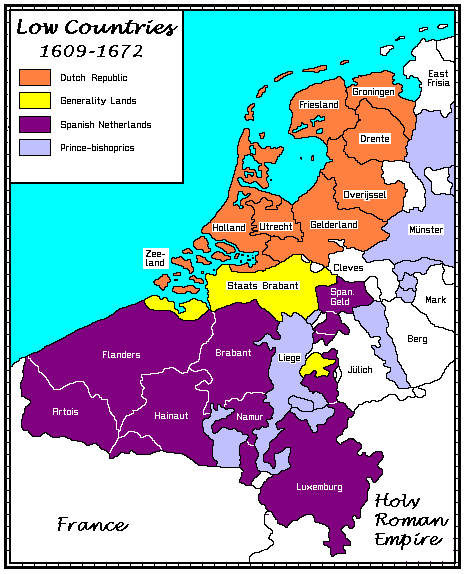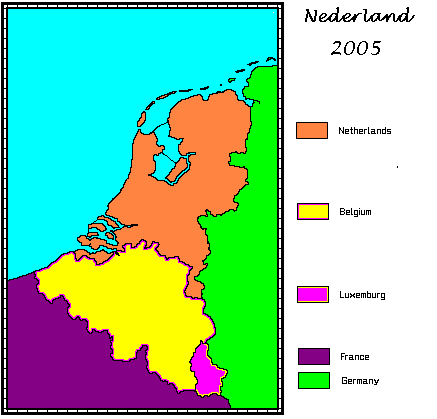Dutch, Holland and The Netherlands
There is no such thing as "Holland". It is a
word, maily used by foreigners, to describe The Netherlands.
Dutch people don't use "Holland" in their own language to
describe their country. Their country is Nederland (singular), and the
laguage they speak is Nederlands.
Only once in its recent history, and just from 1806-1810 during the French
occupation, the brother of Napoleon Bonaparte, Louis Napoleon who ruled the country
officially called it "Kingdom Holland". But that was just for 4 years.
Introduction.
Is it called The Netherlands, Holland or The Low Countries. There is some confusion about
the name. Today, the official name is “Koninkrijk der Nederlanden” (Kingdom of
the Netherlands). The name is plural because it includes the Netherlands Antilles, but the
country in Europe is just called “Nederland” (singular).
The Tenth Century.
In the tenth century, the area on the North Sea became the County of Holland.
The name was an adulteration of the word “Holt-Land”, which means
“Wood-Land”, because the area was so wooded.
The Middle Ages.
In the early Middle Ages the country was an assemblage of counties, duchies and dioceses,
all of which were a part of the German Empire (the Holy Roman Empire). An important part
of this area was the County of Holland. Little by little (mostly by marriage) the titles
of the remaining regions came to be held by the dukes of Burgundy. In 1477 the duchess
Mary of Burgundy married emperor Maximilian I of Habsburg. Because of this marriage the
Dutch areas became a possession of the Habsburgs. The Habsburgs also held possessions in
Austria, and most of the time the Habsburgs also reigned as emperor of the German Empire.
After emperor Maximilian I of Habsburg came his son Philip, who married queen Juana of
Spain. Their son Charles [emperor Charles V of Germany] was the next ruler. In 1555/6 he
gave his Austrian possessions and the title of emperor to his brother, and Spain and the
Netherlands to his son Philip [king Philip II of Spain].
The name of this agglomaration of counties became “de Nederlanden”
(the Netherlands” or “the Low Countries”).

The schism.
It is important to know that until 1579 the name “Netherlands” also included the
territory which is now known as Belgium. On 6th January 1579 these southern regions of the
Netherlands signed the “Union of Atrecht”, in which they declared that they were
prepared to be loyal to the Roman Catholic king Philip II of Spain. In reply, on 23rd
January 1579 the seven northern areas signed the “Union of Utrecht", in which
they declared that they were not able to comply to the orders of this Roman Catholic lord.
This created a schism, splitting the Netherlands into northern and southern sections
(Today known as Nederland and Belgi ).
The independence.
The Netherlands finally gained independence from the Habsburgs in 1581. The country was
renamed “the Republic of the Seven United Netherlands". The words
“Seven” and “United” were not always used, so there are also shorter
versions of this name. In fact, the word “republic” was a bit misleading,
because most of the time there was a Prince of Orange ruling the country as stadhouder
(royal “head of state”), king in all but name. Often the country was also called
“the Seven Provinces".
Family Names
In 1672 Holland is invaded by the armies of Louis IVX, the French Sun King. At that time
most Dutch families did not have last names. Most men's names were like Willem Adriaansz
(Adriaan's zoon. The word "zoon" is pronounced in full) and the unmarried
women's names were like Jantiena Gerrits (the daughter of Gerrit, but the word daughter
was not pronounced). The French formalized the necessity of registering last names.

The French time.
In 1795 the revolutionary French Republic invaded the Netherlands. The country was
reformed on French model by its new masters and was named “Bataafse Republiek”
[Batavian Republic], because the tribe of the Batavians were believed to be the ancestors
of the Dutch people some 2000 years ago.
From 1806 until 1810, the country was ruled as a kingdom, with Napoleon’s
well-meaning brother Louis Napoleon as king. It was called “Kingdom Holland".
This was a misleading name, because Holland was only one of the seven provinces (there
were six other provinces, but apparently they were not important).
From 1810 until 1813, the country was part of the French Empire, ruled directly by emperor
Napoleon I. Once Napoleon had lost control of Germany, the British sent a small
expeditionary force to aid the Dutch and the French were rapidly forced out.
The modern time.
From 1813 until 1815, the country (then called “the United Netherlands") was
ruled by prince William I, son of the last stadhouder prince William V.
In 1815, the Congress of Vienna decided that the Southern Netherlands would be
rejoined with the country (if only to take it out of French control), and that prince
William I would be elevated to the status of king. The country was then called
“United Kingdom of the Netherlands".
In 1830, the Southern Netherlands revolted against king William I, and in 1831 they
proclaimed their independence and called their new country Belgium. Their independence was
recognized by the Dutch government in 1839 and after the split the northern part was
simply called “Kingdom of the Netherlands".
The name Kingdom of the Netherlands remains to the present day.

The origin of the word “Dutch”.
The English word “Dutch” seems a bit strange, but it is derived from the old
Dutch word “Duits”, which then meant “from the people”. Nowadays they
only use this word when they talk about their neighbours, the Germans (who call their own
country “Deutschland”).
The Netherlands and House of Orange.
Talking about the Dutch history is impossible without mentioning the role of the House of
Orange. Since the country's independence in 1581 until today, the Netherlands have been
ruled by a member of this House (with only interruptions in the periods 1650-1672,
1702-1747 and 1795-1813).
Amsterdam and Amstelredam
In some engravings in this exhibition you can see the word
"Amstelredam". It was the very original name for Amsterdam. In the 1200s, the
river Amstel was dammed, where now the Dam Square (with the Palace) is. Around the dam and
the "harbor" grew a small fishing village, that was called "Amstel's
Dam", or Amstelredam. The adjective for Amstel would be Amstelre, resulting in the
name Amstelredam. In time the name was shortened to Amsterdam.
Over the years, small fishing boats gave way to trading vessels, and as land reclamation
progressed, so the city grew and the small port became prestigious land. By the early
1400s, the Nieuwe Kerk (New Church) was being built, quickly followed by the Town Hall.
The Town Hall (now the Royal Palace) controversially took pride of place over the church
and dominated the large open square in size and positioning.
Abstract and input by Willem van Osnabrugge, Ringling Museum Docent.
and home.zonnet.nl/d.van.duijvenbode/geschnl.htm
The maps above were taken from: www.zum.de/whkmla/histatlas/lowcountries/haxnederland.html
That website has a 9 chapter history on the Netherlands. It is called:
History of The Netherlands 1340 - 1702
|


